Full and Partial Dentures
What is a total or partial prosthesis?
Full denture:
Dentures are prosthetic devices constructed to replace missing teeth, and which are supported by surrounding soft and hard tissues of the oral cavity . Conventional dentures are removable, however there are many different denture designs, some which rely on bonding or clipping onto teeth or dental implants. There are two main categories of dentures, depending on whether they are used to replace missing teeth on the mandibular arch or the maxillary arch. There are many colloquial terms for dentures such as dental plate, false teeth, choppers falsies & gnashers. If someone looses all his teeth a full denture has to be done.Lately full dentures are not the only tratment alternative for edentulous people since the implant technology and psosthesis that are fabricated by their support is offering them huge opportunities to be able to chew as with ones teeth.
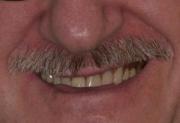
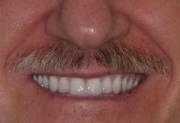
Partial dentures:
A removable partial denture (RPD) is for a partially edentulous dental patient who desires to have replacement teeth for functional or aesthetic reasons, and who cannot have a bridge (a fixed partial denture) for any number of reasons, such as a lack of required teeth to serve as support for a bridge (i.e. distal abutments) or due to financial limitations.The reason why this type of prosthesis is referred to as a removable partial denture is because patients can remove and reinsert them when required without professional help. Conversely, a “fixed” prosthesis can and should be removed only by a dental professionalIn partly edentulous patient by using the remaining teeth as rests some metal acrilic prosthesis that are attached to remaining.
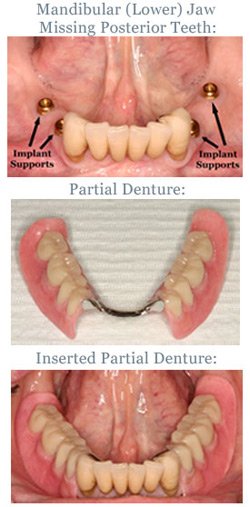
How are the prosthesis constructed?
The fabrication of a set of complete dentures or partials is a challenge for any denturist, including those who are experienced. There are many axioms in the production of dentures that must be understood, of which ignorance of one axiom can lead to failure of the denture case. In the vast majority of cases, dentures should be comfortable soon after insertion, although almost always at least two adjustment visits will be necessary to remove sore spots. One of the most critical aspects of dentures is that the impression of the denture must be perfectly made with the impression trays made individually for the patient after the preliminary impression was made and used with perfect technique to make a model of the patient’s edentulous or partly edentulous (toothless) gums. The denturist must use a process called border molding to ensure that the denture flanges are properly extended. The impression session is followed by another session where the biting records are taken and tooth shade,form and size is determined with the patient,later a try-in is made and it is evaluated from every aspect such as function esthetics and fonetics.If in case some arrangements have to be done they are done.according the needs.An endless array of never-ending problems with denture may occur if the final evaluations of the denture is not made properly. A dentist may do a good job, but only if he or she is meticulous and usually he or she must be experienced.
The maxillary denture (the top denture) is usually relatively straightforward to manufacture so that it is stable without slippage. The lower full denture tends to be the most difficult because there is no “suction” holding it in place. For this reason, dentists in the late 1990s have come to a general conclusion that a lower full denture should or must be supported by 2-4 implants placed in the lower jaw for support. A lower denture supported by 2-4 implants is a far superior product than a lower denture without implants, held in place with weak lower mouth muscles. It is routine to be able to bite into an apple or corn-on-the-cob with a lower denture anchored by implants. Without implants, it is quite difficult or even impossible to do so.
Some patients who believe they have “bad teeth” may think it is in their best interests to have all their teeth extracted and full dentures placed. However, statistics show that the majority of patients who actually receive this treatment wind up regretting they did so. This is because full dentures have only 10% of the chewing power of natural teeth, and it is difficult to get them fitted satisfactorily, particularly in the mandibular arch. Even if a patient retains one tooth, that will contribute to the denture’s stability. However, retention of just one or two teeth in the upper jaw does not contribute much to the overall stability of a denture, since a full upper denture tends to be very stable, in contrast to a full lower denture. It is thus advised that patients keep their natural teeth as long as possible, especially their lower teeth.
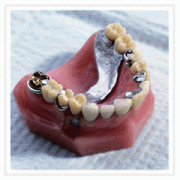 Advices about the dentures
Advices about the dentures
It takes time to get accustomed to full or partial dentures.This may take up to 2 months.Sometimes the patients are supposed to wear their prosthesis without taking it out in order to be able to show the dentist the problems that are present. This way it is possible to determine the problems and the dentist does a few adjustments to sort it out.Since the soft tissues remodel continously with the underlying bone it is a very common problem that dentures may cause problems from time to time. Problems with dentures include the fact that patients are not used to having something in their mouth that is not food. The brain senses this appliance as “food” and sends messages to the salivary glands to produce more saliva and to secrete it at a higher rate. This will only happen in the first 12 to 24 hours, after which, the salivary glands return to their normal output. New dentures can also be the cause of sore spots as they compress the soft tissues mucosa (denture bearing soft tissue). A few denture adjustments for the days following insertion of the dentures can take care of this issue. Gagging is another problem encountered by a minority of patients. At times, this may be due to a denture that is too loose, too thick or extended too far posteriorly onto the soft palate . At times, gagging may also be attributed to psychological denial of the denture. (Psychological gagging is the most difficult to treat since it is out of the dentist’s control. In such cases, an implant supported palateless denture may have to be constructed or a hypnotist may need to be consulted). Sometimes there could be a gingivitis under the full dentures, which is caused by accumulation of dental plaque.One of the most common problems for new full upper denture wearers is the loss of taste.Another problem with dentures is keeping them in place. There are three rules governing the existence of removable oral appliances: support, stability and retention.
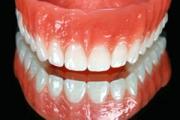 Problems that may develop with dentures
Problems that may develop with dentures
Speech difficulties and unwanted sounds, such as clicking, whistling, smacking, etc.
Difficulty chewing certain foods
Lack of suction / adhesion
Wrinkles above / around lips or at corners of mouth
Constant sore spots in the mouth
Soreness at corners of mouth
Esthetical concerns
Bad breath
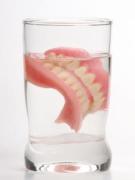 How can I kep my dentures clean?
How can I kep my dentures clean?
- Wash your dentures under running water after each meal and remove food debris
- Especially before going asleep please regularly brush your prosthesis which will eliminateplaque and stain formation.
- While brushing use denture cleaners or dentifrice and do not use abrasives,because the denture gets scratches and on these spots plaque and stain accumulats more
- Specially fabricated denture brushes or regulat toothbrushes may be used paying attention to clean all its surfaces.
- From time to time you may leave your denture in chemical denture cleaning solutions for a more proper cleaning but you have to wash thoroughly before inserting it back yo your mouth.
- Tartars and deep stains can only be cleaned by ultrasonic devices at dentists office .
- The best way to keep the denture clean is daily brushing combined with two denture cleaning tablet applications a week.
What are the guidelines that a full or partial denture wearer has to follow?
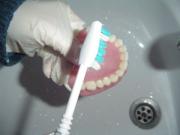 After every meal please clean your prosthesis by using toothbrush and dentifrice. Research has shown that cleaning the denture under running water rubbing with fingers not only failed to do a proper cleaning but spread the bacteria on the fingers on the denture as well.
After every meal please clean your prosthesis by using toothbrush and dentifrice. Research has shown that cleaning the denture under running water rubbing with fingers not only failed to do a proper cleaning but spread the bacteria on the fingers on the denture as well.- If you feel like dropping your prosthesis because it is slippery please do the cleaning on a soft towel.This will prevent the prosthesis from falling and breaking.
- Continous brushing the prosthesis will take away the lpolish which ends up with more plaque accumulation and staning.This will make it difficult for you to do the cleaning.In that case itis in your best interest to go to the dentist and have it repolished.
- Do not use bleach,detergents for the cleaning of your prosthesis. they are not ony destructive for the denture material but it is unhealthy as well
- You may use denture cleaners according to their prescription
- The oral tissues the denture sits on are very important as well.Please after you clean your denture brush your oral cavity with a soft toothbrush or clean it with a clean gauze.before you seat your denture back
- With partial dentures you have to be carefull with the clasps.In case the inner site of the clasps which touches the tooth are not properly clened from food debris they will eventually damage the tooth.
- When you take out yor dentures please leve it in a cup of water.
- Please do not try or let someone eldse try to do some adjustments on the denture and in case you are not comfortable please go and visit your dentist and let him fix the problem
- Please visit your dentist regularly to avoid further bigger problems and to be able to take action in advance.
- Do not forget that your dentures has also a lifespan.Depending on the case generally every 5 years as a general accepted rule the dentures have to be reaevaluated and in case it is needed they have to be replaced with new ones.otherwise the adaptation of the dentures with soft tissues won’t be ideal and the use of the dentures will be much more difficult.
Please do not hasitate to contact your dentist in cases not mentioned above.
What are the precision attachment partial dentures?
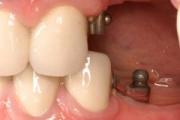
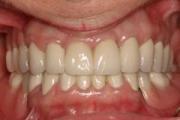
A precision attachment is a precision-machined male and female (key and lock) housing that connects a removable partial denture to fixed bridgework. The female part of the attachment is soldered to fixed crowns or bridgework the male part is attached to the partial denture. The male is machined by the manufacturer to fit the female with such precision that any male out of the box will fit any female with an exact degree of accuracy. All of the precision attachments in a partial denture are positioned so that they are exactly parallel to each other.These type of prosthesis does not contain any clasps that may interfere with the appearance of the patient and are therefore an esthetic solution for people with partially edentulous mouths.
The Advantages of Precision Attachments are :
- Cosmetic Appearance
- Maintainable Periodontal Health
- Longevity of Abutment Teeth
- Patient Comfort
- Questionable Teeth can be saved in a way that does not affect case
- Longevity if they are lost in the future.
- NaturalTooth and/or Implant Abutments can Be Used
- Precision Attachment Partial Dentures Can Be Adapted to Compensate for Future Changes in the Mouth
